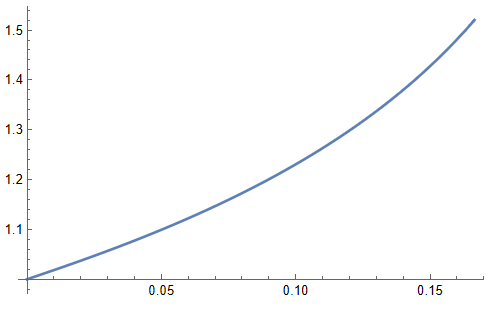$\newcommand\ka\kappa$Let us show that \begin{equation*} \ka(p)=p\quad\text{for }p\in[1/6,1/2]. \tag{1}\label{1} \end{equation*}
Indeed, suppose that $p\in[1/6,1/2]$. Write \begin{equation*} \ka(p) = \sup_{t>0}f_p(t), \end{equation*} where \begin{equation*} f_p(t):=\frac{\ln(1-2p+2p\cosh t)}{t^2}. \end{equation*} For real $t>0$, let \begin{equation*} g_p(t):=f'_p(t)\frac{t^3}2=\frac{pt\sinh t}{1-2p+2p\cosh t}-\ln(1-2p+2p\cosh t). \end{equation*} Then \begin{equation*} \begin{aligned} h_p(t)&:=g'_p(t)\frac{(1-2p+2p\cosh t)^2}p \\ &=t \cosh t-\sinh t-4 p (t+\sinh t) \sinh ^2\frac t2 \\ & \le h_{1/6}(t)=-\sum_{k\ge2}\frac{2^{2k+1}-8k}{6(2k+1)!}\,t^{2k+1}<0, \end{aligned} \end{equation*} so that $g_p(t)$ is decreasing (in $t>0$). Also, $g_p(0+)=0$. So, $g_p(t)<0$ (for $t>0$) and hence $f_p(t)$ is decreasing (in $t>0$). So, \begin{equation*} \ka(p) = f_p(0+)=p, \end{equation*} which proves \eqref{1}.
For $p\in(0,1/6]$, a quick bound on $\ka(p)$ can be obtained from the Kearns--Saul inequality -- see e.g. inequality (1.1), which states that the subgaussian constant for a centered Bernoulli random variable (r.v.) $X$ with parameter $r\in(0,1)$ is no greater than (actually, is equal to) \begin{equation*} c(r):=\frac{1-2r}{4\ln(1/r-1)}. \end{equation*} Note that, if $p\in(0,1/4]$, $X$ is as above, $Y$ is an independent copy of $X$, and $r=r_p:=\frac12-\sqrt{\frac14-p}$, then $X-Y$ will equal your r.v. $\xi$ in distribution. It follows that for $p\in(0,1/6]$ \begin{equation*} \ka(p)\le2c(r_p). \tag{2}\label{2} \end{equation*} On the other hand, by Jensen's inequality for the convex function $y\mapsto e^y$, we have $Ee^{t\xi}=Ee^{t(X-Y)}\ge Ee^{tX}=e^{c(r_p)t^2}$ for some $t>0$ depending on $p$. So, \begin{equation*} \ka(p)\ge c(r_p). \tag{3}\label{3} \end{equation*} So, by \eqref{2} and \eqref{3}, for all $p\in(0,1/6]$ the subgaussian constant $\ka(p)$ differs from $c(r_p)$ by a factor in the interval $[1,2]$.
This is illustrated by the graph $\Big\{\dfrac{\ka(p)}{c(r_p)}\colon0<p<1/6\Big\}$ below:
Added:
The OP wrote: "My end goal was to bound the expectation of the maximum of $n$ such things with a $\sqrt{\log n}$ dependence" ... What is meant here concerning a $\sqrt{\log n}$ dependence is apparently the following: If $\xi_1,\dots,\xi_n$ are standard normal random variables (r.v.'s), then
\begin{equation*}
E\max_1^n\xi_i=O(\sqrt{\ln n}),
\end{equation*}
and, moreover, $E\max_1^n\xi_i\asymp\sqrt{\ln n}$ if $\xi_1,\dots,\xi_n$ are independent standard normal r.v.'s.
However, in contrast with the normal distribution, for small $p$ the distribution of the r.v. $\xi$ as in the OP has rather heavy tails (say in the sense that the absolute moments of $\xi$ grow relatively fast). So, the very slow growth of the expected maximum will not be the case with these heavy tails. E.g., if $X_1,\dots,X_n$ are independent copies of the standardized r.v. $\xi$, then \begin{equation*} E\max_1^n X_i=\frac{1-(1-2p)^n-(2p)^n}{\sqrt{2p}} \sim n\sqrt{2p} \end{equation*} if $n\to\infty$ and $np\to0$, so that $E\max_1^n X_i$ grows asymptotically linearly with $n$ in this regime.

